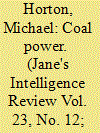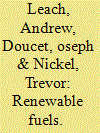|
|
|
Sort Order |
|
|
|
Items / Page
|
|
|
|
|
|
|
| Srl | Item |
| 1 |
ID:
137697


|
|
|
|
|
| Summary/Abstract |
The CA-TIMES optimization model of the California Energy System (v1.5) is used to understand how California can meet the 2050 targets for greenhouse gas (GHG) emissions (80% below 1990 levels). This model represents energy supply and demand sectors in California and simulates the technology and resource requirements needed to meet projected energy service demands. The model includes assumptions on policy constraints, as well as technology and resource costs and availability. Multiple scenarios are developed to analyze the changes and investments in low-carbon electricity generation, alternative fuels and advanced vehicles in transportation, resource utilization, and efficiency improvements across many sectors. Results show that major energy transformations are needed but that achieving the 80% reduction goal for California is possible at reasonable average carbon reduction cost ($9 to $124/tonne CO2e at 4% discount rate) relative to a baseline scenario. Availability of low-carbon resources such as nuclear power, carbon capture and sequestration (CCS), biofuels, wind and solar generation, and demand reduction all serve to lower the mitigation costs, but CCS is a key technology for achieving the lowest mitigation costs.
|
|
|
|
|
|
|
|
|
|
|
|
|
|
|
|
| 2 |
ID:
091594


|
|
|
|
|
| Publication |
2009.
|
| Summary/Abstract |
This article provides an analysis of interdependencies between post-Soviet Erinnerungspolitik in public space and the individual perception of urban reconfigurations by ethnic Germans in Kazakhstan. Applying a qualitative social-geographic approach the author examines determinants of the process of ethnic symbolisation of real and imagined places. Individual biography and the extent of Soviet socialisation are factors shaping the personal perception of symbolic landscapes. From the perspective of the individual, space reflects the power distribution within society and hence, impacts on individual identity formation. Depending on the dominance of internal as opposed to external identification, the (perceived) changing ethnicised landscape of cities potentially fuels ethnic tension.
|
|
|
|
|
|
|
|
|
|
|
|
|
|
|
|
| 3 |
ID:
109248


|
|
|
| 4 |
ID:
150432


|
|
|
|
|
| Summary/Abstract |
Road transport is one of the sectors with highest energy consumptions in the planet, with large dependence of fossil fuels, and contribution for global greenhouse gas emissions. Although, Latin America is not a high-energy consumer, its share in global consumption is expected to grow, especially in the transportation sector. This make essential for developing countries the adoption of better policies to identify the vehicle groups with largest fuel demands. The present study describes the VKT technique to disaggregate road transport energy consumption by vehicle type, applied to the road transportation system of Ecuador. It also describes the procedures performed to estimate the variables required to run the model, and some of the practical applications that be used to create public policies. Results show as the biggest fuel consumers the heavy-duty freight cargo, followed by light duty vehicles. The estimation of greenhouse gas emissions evidence that road transport released 14.3 million tons of CO2 in 2012. When fuel consumption is compared by it costs, it can be confirmed that Ecuadorean Government covered, through subsidies, for 68% of the annual fuel costs of national road transport, demonstrating the importance of restructuring these expenditures in order to achieve an efficient road transport system.
|
|
|
|
|
|
|
|
|
|
|
|
|
|
|
|
| 5 |
ID:
109438


|
|
|
|
|
| Publication |
2011.
|
| Summary/Abstract |
In November 2008, the European Union adopted "The raw materials initiative - meeting our critical needs for growth and jobs in Europe", dealing especially with ensuring the future needs of metallic and non-metallic raw materials for EU member state economies. After years of hesitation, this may undoubtedly be considered a very progressive step. The article lists the most relevant reasons why the EU should promptly proceed to the discussion and preparation of a similar material of higher legal force for energy minerals. Basic problem areas of forming a political platform for the preparation of the EU energy initiative include the exploitation of domestic energy raw material deposits, raw materials diplomacy, and the matter of renewable sources.
|
|
|
|
|
|
|
|
|
|
|
|
|
|
|
|
| 6 |
ID:
105820


|
|
|
|
|
| Publication |
2011.
|
| Summary/Abstract |
This paper examines the impact of government policy on the risk profile of a small ethanol production facility. We derive four key results from a simulation model. First, we show that commodity price risk may discourage investment in a project, despite a positive expected rate of return. Second, we show that political uncertainty may have significant impacts on the risk profile of a project. Next, we show that using only production subsidies to attract investors is expensive, since the financial assistance is paid regardless of whether the plant is operating under positive or negative financial conditions. Finally, we show that a capital grant provides a valuable complement to a subsidy, because the grant reduces the amount of value investors must put at risk, and increases their leverage thereby enhancing returns, while the subsidy mitigates commodity price risk. Our results show that compared to a subsidy-only approach, a grant and subsidy combination provides an investment environment with similar downside protection and expected returns for less than 60% of the cost. Further, we show that the two policy tools combined yield a superior investment environment to that created by an equivalent or greater total investment deployed entirely in either of the policy tools without the other.
|
|
|
|
|
|
|
|
|
|
|
|
|
|
|
|
|
|
|
|
|